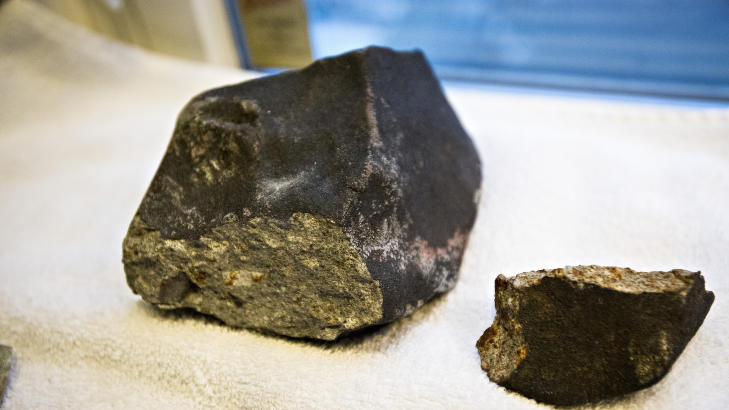
© Geir Barstein
Driven by irritation due to a possible water leak, 6 February Steinar Engh (69) took a ladder to the roof. What he discovered was extremely rare and unexpected: A meteorite had smashed a hole in the villa on Korsvolltoppen outside Oslo.
Experts reviews speak of a sensation. They only know of three previous cases where meteorites have hit an inhabited house in this country.
- I noticed that large icicles on the ceiling of the terrace had formed, and thought that it was water leaking down from the upstairs neighbour's porch on the second floor. I climbed up the ladder and found a hole in the floor. Next to it was a small stone, says Engh.
Engh threw the stone out on the lawn. 69-year-old first assumed it was some rubble from blasting from a quarry had caused the damage, and called for a plumber. A hole was punched through a metal plate and woodwork that make up the porch floor, but the foundation of the roof of the terrace below was still intact.

© Geir Barstein
He ran a hand down the hole.
- And then I found the large stone. It was dry and well into the roof, and it was just luck that I discovered it. If not it would have been built into the house forever, laughed Engh.
The damage was repaired the same day, but Engh said he suspected that the stone with the black surface layer could be a meteorite. He contacted a neighbor who works at the Natural History Museum in Oslo, which was later confirmed that it was a space rock.
- It was an honor to be able to hold a meteorite, which hasn't even touched the ground. The stone has been on a 4.65 billion-year journey, and then it hit my house, Engh says to Dagbladet.
The stone, probably moved at a speed of up to 300 km / h, split in the collision: one large piece, one small and numerous small fragments.

© Geir Barstein
Together they weigh 2.8 kg, representing the fourth largest single meteorite found in Norway, according to Morten Billet of Norwegian meteor network, one of the nation's foremost experts in the field.
He has investigated the spot of impact as well as stone and is one hundred percent sure that it concerns a meteorite.
- It is very, very typical. You see it very well on the black surface layer, the so-called burning membrane. Inside you will find small "corn" called chondrules. It was the primordial matter that floated around space when the solar system was formed, says Billet.
- This is really sensational. We know of only three previous occasions where meteorites have hit inhabited house, he said.
But when the rock crashed into the house is an open question. According to Billet it likely concerns an Oslo meteorite, from a space rock rain over the capital sometime in early March 2012.
Time mystery 
© Geir Barstein
The controversial Grefsen meteorites, which are owned by Knut Jørgen Roed Odegaard and his wife Anne Mette Sannes, weighing a total of 4.6 kg and is the largest of its kind in Norway in 100 years.
The fragment was found among other Rodeløkka, where it had gone through the roof on an allotment.
The controversial pieces that were found on Grefsen and owned by Knut Jørgen Roed Odegaard and his wife Anne Mette Sannes, weighing a total of 4.6 kg, but is not officially analyzed and verified in the international meteorite register.
Enghs house is located right in the area where collectors anticipated that several pieces fell down, along the estimated route that followed the space rock as it broke through the atmosphere.
- If you look at the stone, it is almost identical to the second Oslo meteorites. Chances are it is from another meteorite fall is extremely small. It would be like winning the lottery three times in a row, says Image.
Engh is unsure when the hole in the porch may have occurred.
- We do not know. I'm never on the porch, and my tenant uses it very rarerely, says Engh, who has wondered if it might stem from a blow his wife and daughter heard last October.
analyzed 
© Geir Barstein
He has provided samples to the Natural History Museum (NHM), University of Oslo so that they can perform analysis. In a few weeks it will be clear whether it is a new Oslo meteorite, or whether it stems from an entirely different and unprecedented case.
Geologist and Associate Professor Rune Selbekk at NHM agree that it most likely is an Oslo meteorite.
- They are very, very similar in look. Now we take a so-called thin-section to check the internal structure, and then we will see if it's a different case. The probability is small, but it's there, says Selbekk Dagbladet.
Meteorites can be very valuable if they are of a rare type. The variant Engh found called chondrites and is common, but it is big and has hit a house - which is very unusual, even worldwide - means that the value can reach several tens of thousands of dollars.
Engh, however, is not in a hurry to get rid of it.
- In the first place I'll take good care of it. It should be recorded and investigated at the university, and I have no immediate plans to sell it or do something else. It shall be safe and dry, he said.

© Geir Barstein

© Geir Barstein
Comment: "Extremely" rare?
12 March 2012: Meteorite chunk falls on Oslo
14 March 2012: Another meteorite found in Oslo